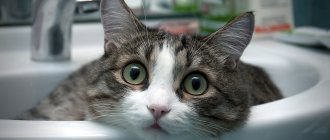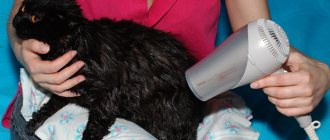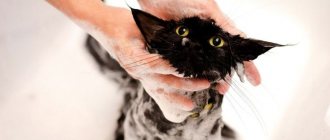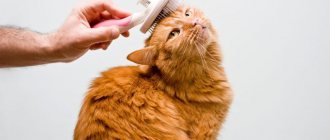Loving water treatments is a rare occurrence for a cat. These animals are very clean, but even the sound of water gets scared and hides somewhere. The task of the animal owner is to create the proper conditions: choose a detergent, prepare the pet, determine the water temperature for a comfortable bath for the cat. This article will help the caring owner find out his cat's needs for the right water temperature, and will also tell you why veterinarians recommend adhering to these standards.
Rules for swimming
Many people believe that cats are terrified of bathing. The aversion to water is based on the animal's subconscious instincts for safety reasons. If you are properly accustomed to bathing while still a kitten, then there will be no problems with this. It should also be noted that bathing a sick animal is prohibited. This can affect your pet's immune system, resulting in serious illness.
Before you start washing, you need to take care of your cat's ears and eyes. When applying shampoo, soap suds can get on the mucous membrane of the eyes and ears. Therefore, you need to use eye drops for your eyes to prevent irritation and pain. Use cotton swabs to protect your ears.
Ways to bathe pets
- As a container, you can use a sink or a small basin filled with 10-12 cm of water. The suitable water temperature for washing is 39°C. To prevent the paws from sliding on the enamel surface of the sink, place a towel on the bottom;
- You need to pour a small amount of shampoo or gel into a bag that is capable of allowing water to pass through and place the pet’s body, leaving the head outside. The cat should be held by the scruff of the neck with a soft but firm grip. When lowering the cat halfway into a container of warm water, you need to make circular movements with your hand, saying kind, gentle words. The animal must feel the safety of the actions being carried out.
When bathing, you can use a non-rough sponge to wet all the fur except the head. It is necessary to rub the shampoo in with massaging movements so that a layer of foam is formed. Some breeds find this procedure enjoyable and may even purr. If there are fleas, you need to wash your hair, but very carefully. To do this, you need to soap the surface of your head with a well-wrung out sponge so that the foam does not flow onto your eyes, ears and mouth.
You need to wash off the foam with water, which should have a temperature of 39-40°C. The stream of water should be directed from head to tail in the direction of the fur. You should thoroughly rinse the area of your armpits, belly and under the tail. The second step is to apply the balm, which also needs to be rinsed. After the procedure, the cat should be wrapped in a warm terry towel. When drying, it is not recommended to rub vigorously, otherwise the long hair will become tangled. While drying, the pet should be kept warm, after which the fur should be combed well.
The importance of compliance with these standards
One of the main reasons why cats refuse to bathe is an anxious situation. Everything scares animals:
- noise;
- lack of support;
- moisture;
- getting drops on the head, eyes, ears;
- unfamiliar sensations.
Often, a kitten jumps out of a basin or bathtub in fright because it is very cold or hot. Because of the first unsuccessful bathing experience, it is often impossible to persuade the animal to repeat water procedures.
Possible consequences of non-compliance with temperature conditions
The danger of hypothermia is that it increases the risk of developing colds. Against this background, hypothermia often occurs. Most often, owners of small kittens face this problem.
An animal at an early age is not able to regulate its own body temperature, quickly freezes, and because of this, the functioning of the digestive system is disrupted. Accordingly, the body does not absorb nutrients. The pet cannot keep warm.
The risk of death in such a situation is high .
You need to seek help from a veterinary clinic. The skin of pets is very sensitive, so there is a high probability of getting a burn. The owner thinks the water is warm, but for the animal it turns out to be hot. Overheating develops and burns appear.
Another problem that arises when these standards are not followed is dry skin. Such changes are observed when bathing in cold or hot liquid, or when washing the cat frequently.
Wash water temperature
To ensure proper care of the fur, you need to know what temperature is suitable for your cat when bathing. It is determined depending on the characteristics of the breed.
Many animals are thermophilic, so cold water can be dangerous to a cat’s health and immunity. Hot water can burn the skin, frightening your pet and leaving a burn. For simple breeds, an average temperature of 38-39°C is suitable; if the cat feels chills or tries to sneak away, you can increase the temperature to 40 degrees.
When bathing, you need to use special products that are designed specifically for animals. Some gels and shampoos for humans may not be suitable for cats, which can cause irritation, itching and redness of the skin. They also dry out the fur and take longer to wash off with water.
Why don't cats like water?
No, this is not a whim or character flaws, but an instinctive fear. In nature, a wild cat will go into the water based solely on survival instincts. There are exceptions, for example, tigers are swimmers and fishermen who can easily endure water procedures due to the water-repellent structure of their fur. It just so happens that more than 80% of domestic cats hate bathing, while the remaining 20% tolerate it. From the point of view of cat psychology, purrs do not like water because their fur quickly gets wet, and water, especially with shampoo, dries out delicate skin.
If you hope to “twist” your pet and bathe it “somehow”, give up the illusion; without washing the fur, you are risking the health of your ward. In addition, true fear provokes animals to desperate actions, fighting charms and torn clothes are provided to you, and after that, wet slippers and torn wallpaper as moral compensation for the “abuse”.
Why bathe a cat?
Animals are bathed to reduce the volume of sebum, eliminate odor, remove excess hair, etc. The appropriateness of hygiene procedures is determined in each case individually. Cats are clean animals. They spend a lot of time on hygiene procedures. Pets have a rough tongue, so it easily removes dirt and secretions.
Most often, bathing is carried out when the following factors appear:
- Free range or wandering lifestyle. Cats that visit the street bring dust on their hairs. Visually, the wool may appear clean, but in reality, dirt particles settle on it. Over time, they accumulate, air circulation deteriorates, and the skin becomes oily and flaky. This increases the risk of infection.
- Stained wool. Something poisonous, sticky or sweet may get on the hairs. In such cases, independent hygiene procedures can lead to intoxication. If the cat cannot cope with the pollution on its own, it should be helped.
- Shedding. With seasonal temperature changes, the cat’s body adapts to environmental conditions. In pets, changes can occur unnoticed, since there are no sharp fluctuations in indicators. Animals that walk outside suddenly shed their fur. Dead hairs bother your pet, cause itching and impair air circulation. During shedding, the cat often licks itself, which can lead to intestinal obstruction.
- Breeds with a dense undercoat or long hair (for example, Scottish and British cats). In such cases, the pet is not able to take care of the hairs on its own. Some dirt remains on the fur, so it should be removed separately.
- Increased work of the glands. Excessive secretion production may be due to individual characteristics or disease. To prevent unpleasant odor or skin problems, you need to remove excess sebum.
- The appearance of fleas. Special shampoos help get rid of some parasites and temporarily protect the cat from insect attacks.
- Breeds without hair. The body of such cats is different, because their skin is not protected by hairs. As a result, the glands intensively secrete secretions for hydration. With its excess, dermatological diseases develop.
Additionally, procedures are carried out before the exhibition. The owners use special detergents and powders to give the animal the appropriate appearance.
In other cases, it is recommended to avoid swimming. Excessive use of detergents contributes to the disruption of microflora, which can lead to allergies, dandruff, cracks in the skin, etc. If the water temperature for bathing cats is chosen incorrectly, there is a risk of exacerbation of chronic diseases or the development of infectious pathologies.
When to wash a kitten for the first time
If you just bought a kitten, you shouldn’t bathe it right away - let the baby get comfortable in the new place. Changing a place of residence is always stressful, especially for small ones; it is worth postponing a little with water procedures. It will take several months for the tail to get used to its new home. Clean, domestic cats just need to be lightly brushed for up to 3 months using a sponge lightly soaked in water.
This rule does not apply to cats that were taken from the street. They need to be washed thoroughly using anti-parasitic flea and tick products, and also bathed with laundry soap. It would also be a good idea to see a veterinarian.
Thoroughbreds will have to be washed more frequently, so they need to become comfortable in the water from an early age. Bathing procedures can begin at 3-4 months.
How often can you bathe a cat?
The schedule for hygiene procedures depends on the individual characteristics of the animal and the conditions of its detention.
- If the cat does not go outside and lives in a clean room, it can be bathed every 3-6 months.
- If your pet is free-ranging, you need to bathe your pet every 1-2 months.
- Representatives of hairless breeds are bathed every 2 weeks in summer, and once a month in winter.
Kittens are bathed only after 4 months, when their teeth change. It is advisable to abandon additional hygiene procedures until adulthood, since in small animals the thermoregulation system works less well. This increases the risk of developing diseases.
You should not bathe your cat too often, as animals have more delicate skin than humans. During the procedures, the protective fatty film is washed off. This can cause increased secretion, poor air circulation and flaking of the skin. To prevent side effects, it is advisable to skip procedures whenever possible and use special gentle shampoos.
You can bathe your pet with warm water without using detergents without restrictions.
Breed influence
Cats with fur feel good when bathing if the water is heated to a comfortable temperature equal to body temperature.
Sphinxes are a completely different matter. This breed is characterized by the absence of hair, so the animals quickly freeze and become hypothermic.
They have different requirements for water: it is heated to +39…+40°C.
It is necessary to monitor the air temperature: if it is cold, bath procedures will cause hypothermia. The risk of developing colds increases.
Proper drying of a cat after washing
After the procedure, you should take 2 thick terry towels. The fabric should be soft. First, the cat is gently dried. If your pet is nervous, just blot the fur and let him shake himself off. After removing excess moisture, the animal is wrapped in a dry towel and transferred to a warm room for further drying.
It is forbidden to leave your pet wet, create drafts, keep your pet in a damp cloth, etc. For cats, bathing is not a natural method of cleansing. Wool supports the functioning of the immune system and prevents sudden temperature fluctuations. Wet hairs do not hold air and can cause hypothermia. It must be borne in mind that a temperature that is comfortable for humans may not be suitable for a cat.
Should I bathe my cat?
Cats are afraid of water, so bathing is a serious stress for them. By regularly licking and washing, cats keep their fur clean. However, in some situations it is necessary to bathe a cat:
- If the wool is very dirty;
- The animal was found to have parasites;
- The cat got dirty in toxic substances, such as fuel oil;
- During the molting period, to remove dead hairs.
Washing is additional hygiene for the animal, prevention against parasites, softening and moisturizing the skin, removing lost hair, and simply maintaining the aesthetic appearance of your cat. Therefore, every owner needs to know how to bathe a cat correctly.
How often to bathe a cat
It depends on his lifestyle. On average, a cat requires 5-6 baths per year.
Regular bathing is inevitable for show animals, as their fur is evaluated very carefully. Hairless cats need to be washed frequently because they sweat through their skin. Long-haired dogs are bathed so that less hair falls out.
Kittens should be bathed no earlier than three months of age. Water procedures for small kittens can lead to hypothermia and the baby catching a cold.
How to bathe a cat for the first time?
So, we found out that your cat should first become acquainted with water and shampoo at a young age. It should be remembered that a kitten has a vulnerable child’s psyche. The owner’s task is not to instill in the baby a persistent aversion to water and the entire procedure as a whole. To do this, you must follow some rules. The baby’s attitude towards this procedure in the future depends on the very first bath.
A kitten should be accustomed to water from three months. Usually, before this age, his mother washes him out. However, there are exceptions to every rule. If a kitten is very dirty at the age of one month, then it can and should be bathed. You should not carry out the first procedure in the bathroom. A basin is more suitable for this, as it doesn’t look as intimidating to a baby as a huge white bathtub, and it will also be easier to keep him in the water.
You need to pour a little water so that it just reaches the kitten’s tummy. While bathing, talk to your baby in a quiet voice and call him by name. Do not wet the kitten's head from the shower; clean the fur on it with a sponge. Use shampoo for kittens, choosing it based on your pet's coat type. If you can’t purchase it, use any children’s one.
Preparation
The procedure must be carried out in such a way as not to harm the animal’s mental state or frighten it. Otherwise, the cat will associate bathing with negative emotions, and subsequent implementations of this event will end in the animal’s hysterics. Before you start swimming:
- Fill a couple of basins with water. During the washing process, it is advisable not to use a shower or tap, as the noise of the water can frighten the animal. It is also better to collect water in the container without a pet;
- Place a rubber mat on the bottom of the basin: this way the cat can grab hold of its claws and not slip. The pet will feel more confident;
- The amount of water you need to fill is approximately the size of the animal’s belly. The temperature should be 35-37 degrees Celsius, in the room no colder than 15 degrees;
- Prepare several towels in advance and place them within reach;
- Prepare a special shampoo. You cannot wash your cat with human products: this causes the skin to dry out and provoke the occurrence of skin diseases.
If the cat has long hair, then brush it before bathing to prevent the hair from matting.
How to wash your eyes and clean your ears
The washing procedure was completed, your eyes and ears were left unwashed. But they also need cleaning. This can be done by lifting the cat out of the bath. Wipe your eyes with ear swabs moistened with water or chamomile tea. Rubbing is carried out with light movements, do not put pressure on your eyes.
It’s better not to touch the ears again. Wash them only if they are heavily soiled. Or wipe with ear swabs if water gets into your ears during washing. To do this, it will be most convenient to wrap cotton wool around a tampon. To clean, you can soak the ear stick in a small amount of Vaseline. After cleaning, the ears should be pink, dry, free of dirt and foreign odors.
Cat bathing procedure
Place a container of water at hand level, for example, in a sink. Hold the cat so that it cannot move its paws. Talk kindly to your pet and do everything carefully, without causing pain or discomfort to the animal:
- Gradually lower the cat into the basin. Wet the fur by scooping water into your palm and pouring it over your pet, stroking it as you do so. Never pour water on your head to prevent water from getting into your ears, eyes and nose;
- Lather the animal with shampoo according to the instructions. If you use an emulsion to eradicate parasites, you will need to leave the product on for 5-15 minutes;
- Rinse the animal several times until the water in the basin is clean, also avoiding getting it on the head.
- Carefully remove the animal and wrap it in a towel. Do not squeeze the fur so as not to hurt your pet;
- Leave the cat in a warm room until completely dry;
- Brush your cat when dry.
How to teach a kitten to bathe
Bathing a small kitten when it is only a month old is not recommended unless absolutely necessary. If, for example, he gets his paws dirty in the tray, they should be wiped with a wet napkin and wiped dry, but do not wash the baby all over. It is optimal to start accustoming a kitten to water starting at the age of 4 months. This process is quite lengthy and requires patience from the owner, since not every kitten, despite all efforts, is able to get used to bathing. In order for a kitten to stop being afraid, you need to teach it to wash in water in the following sequence:
- the kitten gets acquainted with the bathing basin - it should not cause fear in the animal. First, you need to show the basin to your pet, and then put the baby in it even before the water is poured. Then the kitten is taken out;
- water at a temperature of 38-40 degrees is poured into the basin to a depth of 5-7 cm;
- the kitten is placed in a basin of water, speaking to it in an even, calm voice, while at the same time holding it tightly;
- The pet's head is quickly wetted, making sure that water does not get into the ears and nose. They try to wash it briefly, since the kitten, as a rule, does not like to bathe.
If the kitten is very nervous, then before bathing you should give him a little sedative designed specifically for kittens. Regarding which product to choose and in what dosage to give it, it is worth consulting with a veterinarian.
© shutterstock
It is important to remember that the sooner the bathing is over, the better. You should not force your kitten to endure unnecessary exposure to water.
About water procedures
– There are a lot of disagreements and disputes around whether cats need to be bathed. Many owners believe that it is not necessary to wash animals, because mustachioed animals are very clean and take excellent care of themselves. This is partly true,” says veterinarian Oksana Levchenko . – You should bathe cats only if they are dirty and cannot clean themselves. But you shouldn’t do this more often than once a month. This risks washing away their protective lipid layer and causing the animal to experience itching and flaking.
How to prepare for washing?
Before bathing, feed your pet and play with it. You need to make sure that the purr splashes out as much energy as possible before water procedures and does not make you run around in the bathroom.
Prepare shampoo and a towel in advance so that you don’t leave your pet alone in the bathroom if you decide to run to another room for something. Also, remove all objects that the cat could touch or break if it wants to escape from you.
How to bathe correctly? Do this in the bathtub, sink or basin. Place a rubber mat on the bottom so that your pet can cling to it with his claws. The water should be warm, preferably 38 degrees. You need to gain about 7-8 centimeters. Cover the purr's ears with cotton wool to prevent water from getting in. Do not wet the animal's head.
Which shampoo to choose? Use special shampoo for cats. It is sold in pet stores and veterinary pharmacies. The usual shampoo that the owners use will not work, since humans and animals have different skin acidity.
At what age can kittens be bathed? Very young kittens, less than two months old, do not need to be bathed. From the age of three months you can begin to accustom him to water. You shouldn’t immediately drag your pet into the water; start by wiping its paws.
What if the cat is afraid of water? There is a solution - dry bathing. It is enough to wipe hairless cats with special wipes, while short-haired cats can be cleaned with bran.
To do this, you will need from 0.5 to 1 kg of bran, which needs to be heated in the oven. The bran should be warm, but not hot. If you cannot pick them up yourself, under no circumstances wipe your pet with them so as not to burn them.
Pour warm bran into a tray, box or newspaper, place the purring furry in it and begin to wipe it with both hands, then wipe off the remaining residue with a towel. In most cases, the animals like it. Cats love warmth. After this procedure, the coat will become more shiny.
What makes cats afraid of water?
Driven by curiosity, scientists have put forward several theories to explain the causes of irrational phobia in most members of the cat family. In the course of their research, they came to the conclusion that it is not fear that motivates cats to avoid contact with water, but the instinct of self-preservation.
Cats are excellent swimmers, capable of covering long distances. A 1-month-old kitten submerged in water, for example, can swim without assistance.
Whiskered pets not only hunt well, but also swim well
Table 1. Main factors provoking fear of water procedures
| Cause | Explanation |
| Risk of hypothermia | There is an air cushion between the top layer of hair and the dermis. It absorbs heat emanating from the body and warms the pet. When wool gets wet, it loses its insulating properties. |
| Possibility of overheating | The air gap protects from overheating by preventing exposure to sunlight. For dogs, for example, to survive the heat, it is enough to breathe with their tongue hanging out. Cats that do not have this ability can only rely on a pillow. |
| Increased smell | When the fur gets wet, it gives off a strong odor and makes the animals vulnerable to large predators. In addition, such a clear cat scent complicates the hunt. The victim senses the approach of the enemy and manages to escape in a timely manner. |
| Growth of pathogenic bacteria | Wet hair absorbs more dust than dry hair. When washing, dirt enters the cat's stomach and provokes the proliferation of harmful microbes. |
Zoologists believe that cats are aware of the negative consequences of bathing and do not want to put themselves at risk. They remember at the genetic level that wet wool contributes to heat loss.
In the large family of cats there are lovers of water treatments. These include servals, tigers, Sumatran cats and jaguarundis.
Unlike cats, dogs can shake off water.
While observing the behavior of cats and dogs, researchers made another interesting discovery. Representatives of canines are active hunters. In pursuit of prey, they cover long distances. If they need to dry off, they either shake off drops of water or get rid of moisture while jogging. Fluffy pets obtain food in a less energy-consuming way. They spend most of their time in ambush, patiently waiting for prey. And they don’t know how to shake themselves off.











